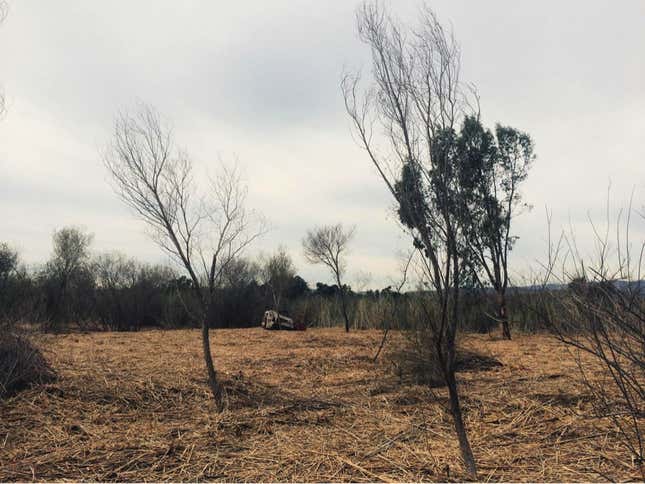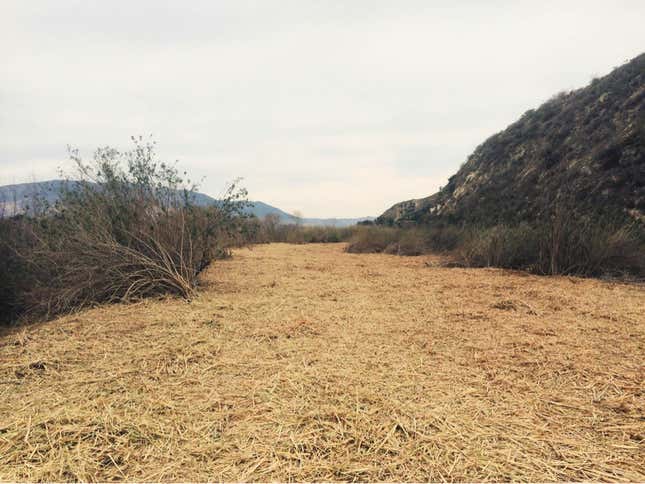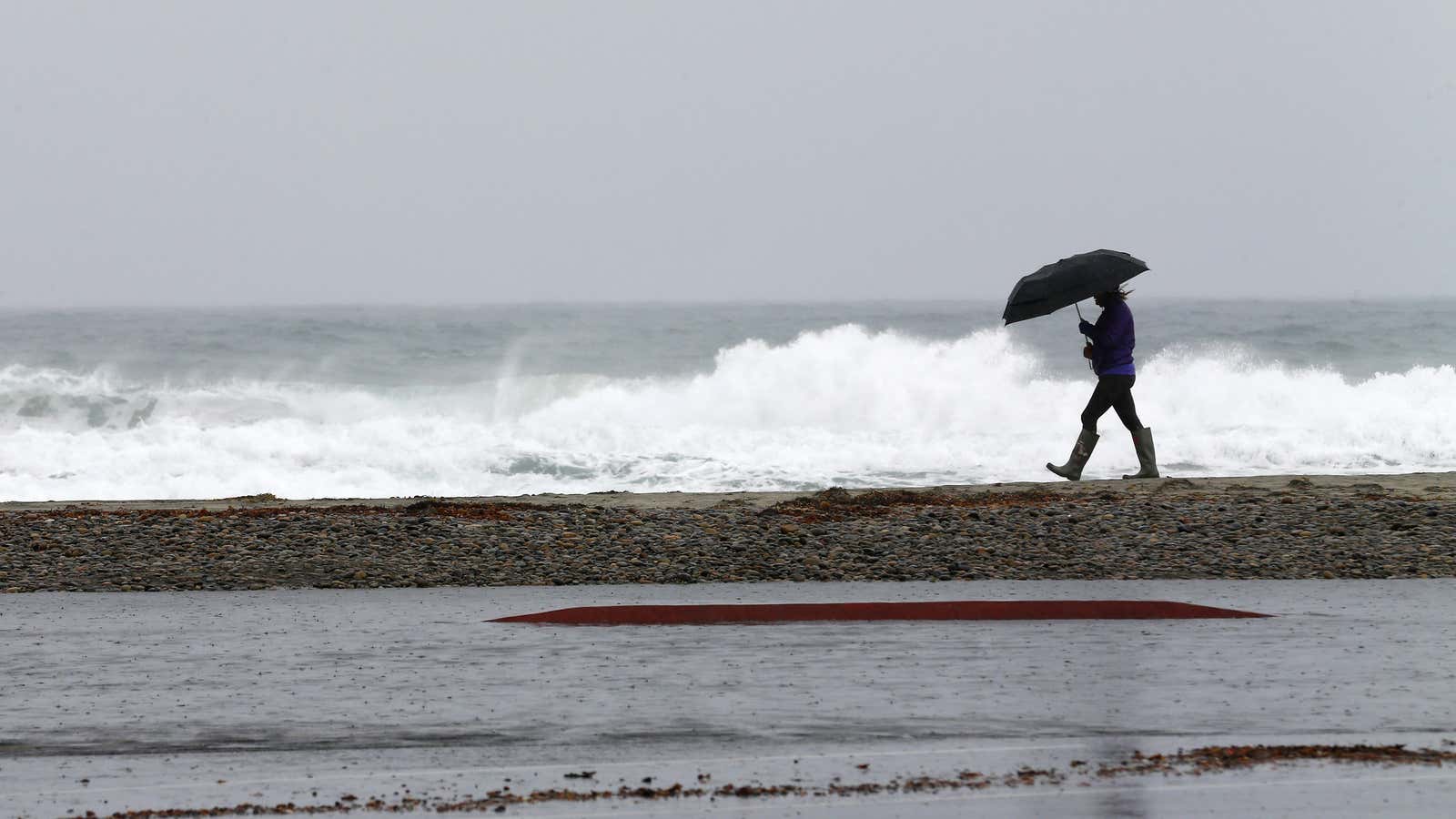As I sit down to write this, the sky is darkening, thick with cloud cover and turning sinister. Outside I can hear a light breeze through the pepper trees. Soon it will strengthen and, sometime tonight, or in the early hours of dawn, it will begin to rain, hard and long enough to puddle, pool, and flood. Many of my clearest memories growing up in California are of the rain, it has always been a rare and notable occurrence. There’s a story, probably apocryphal, that the rain came so infrequently when I was very young that by the time I could form sentences, one of my first was to ask what it was, the stuff falling down from the sky. I was born in a drought year. I will likely die in a drought year, too.
The second reason I can recall the rains of specific years is because they nearly always brought disaster. There was the town just down the coast from us that became partially buried in a mudslide, there was the neighbor’s yard that swept away after a dry creek turned into a torrent, there were all the photographs of surfers and kayakers paddling across flooded freeway underpasses or through supermarket parking lots, or, worse, the news reports featuring a car caroming down a wide wash, feeling its first rainfall in years. In California, water is scarce until it isn’t. Then there’s simply way too much.
Tomorrow it will be the same. It will rain and rain, pool, puddle, and flood. In Los Angeles, where I now live, the water will pick up all number of toxins like lead and zinc and fecal bacteria, it will overwhelm storm drains and sewage treatment plants, and nearly all of what was once fresh, good, useable water will be swept out to sea, on concrete channels built by man. The National Resources Defense Council estimates that, each year, in the U.S., we lose 10 trillion gallons of stormwater due to our constructed environments, our roads and roofs and parking lots. We’ve paved paradise, yes, and made it woefully impermeable and inefficient in terms of our water demands. In Southern California, where the demand outpaces supply and the need is especially acute, the rain brings bitter irony: traffic will snarl and stop, the flooding will be costly, and still the city will bring most of its water in from hundreds of miles away. This rain will not save us from the drought—no, only the land will.
Yesterday, while the storm was still way off the coast of Northern California, I stood in a bone-dry river bottom and thought about the coming flood. I was about 10 miles east of Ventura, and the Pacific Ocean, in the only free-flowing (that is, undammed) river left in Southern California, the Santa Clara. With me were two biologists from The Nature Conservancy. I had come to see their work on the river because it represents a radical shift in how the state has begun to deal with its water, undoing the many mistakes made during the last century, unbuilding what had been built, and tearing out the plants long-ago introduced. On the Santa Clara, that plant is arundo, a tall, bamboo-like grass from Asia that’s food for elephants and havoc on riverbeds throughout the southwestern U.S. Arundo isn’t just bad for native flora and fauna—crowding them out, choking off access—it messes with the soil, trapping nutrient-rich silt and sucking up many times the water that native plants do. When it rains, arundo clogs the river like hair in a shower drain, great clumps of it breaking off and hurting down with the floodwaters, cracking apart bridges, slamming into homes, and damming what used to be wetlands. It furthers the flood, though it was brought to the state at least five decades ago for the purpose of retaining soil, especially on riverbanks, particularly when it rains. It doesn’t even do this.

The scientists—Lily Verdone, the project director in Ventura, and Laura Riege, the restoration manager—were going to show me how they got rid of arundo. It involved a Bobcat, a compact tractor with an hydraulic axe attached, as well as a crew of about five, to supervise and clear by hand the tricky spots, where the arundo grew right up against native trees like willows and mulefat. Another biologist oversaw the work, warned off the frogs, and watched for birds nests to steer clear of. The river supported some 16 endangered species. Mountain lions and black bears were common. Clearing arundo would help support all these species and many more, and was the right thing to do from a conservationist point of view. But the Santa Clara is a remarkable river not simply because it is undammed. It’s also within an hour’s drive of about 16 million people, the second most populous urban expanse in the U.S. It runs through thousands of acres of agricultural land, through small towns and mid-sized cities. There are many, many parties not only interested in the Santa Clara, but have a stake in it. The arundo removal serves them all. For the biologists, it’s habitat restoration; for farmers, it’s land management; for towns, cities, and the whole state, it’s cheap and lasting infrastructure. In fact, a partner on a related Nature Conservancy project downstream, in the former wetlands surrounding Point Mugu and Port Hueneme, is the U.S. Navy, which has bases in both places. Verdone described what an amazing partner the Navy was, because they view the changing climate, rising seas, and floodwaters as a threat to national security. The farmers have taken a similar view, just thinking of their crops rather than our borders, and the Conservancy had been able to buy pieces of the floodplain for cheap, or get easements for access from farms that didn’t sell. Cities like Ventura and Oxnard were incorporating funding for this restoration project and others into civic budgets, because to do so meant spending a little bit now and saving a lot on flood-repair down the line.
The unbuilding of our landscape to make it more like it was before has been given a funny, modern name: green infrastructure. Green infrastructure can be as simple as planting native trees or tearing up a road and digging up the earth to make a swale. The goal is to catch the rain, slow the floods, and store the water away, which the natural landscape of California is quite adept at. Wetlands are still the cheapest, most efficient flood control and water filtration systems we know of (indeed, natural restoration projects often cost 80 percent less than built projects like levees and dams). A study by the NRDC and the University of California, Santa Barbara, found that these sorts of simple, green infrastructure projects could increase local water supplies in Los Angeles by 405,000 acre-feet a year, two-thirds of the city’s current, total water use. Capturing rainwater where it falls, the report is quick to point out, also means huge energy savings, more than a million megawatt hours, which in turn prevents about 535,500 metric tons of CO2 from being released into the atmosphere each year. But its groundwater recharge that is the real key here.

“Every one of these dry rivers has a bowl underneath,” Riege, the restoration manager, tells me. We’re walking through the arundo now, its tall thick strands appear impenetrable, and block on the sun in places. When scientists speak of the drought in the most dire terms, it’s the groundwater that usually comes first, because it’s the groundwater that we’ve depleted the most (just this year, the equivalent of Lake Shasta, California’s largest reservoir, came out of the ground). Groundwater recharge isn’t just important to urban centers but agriculture, which readers of drought-disaster-literature will tell you is exactly 80 percent of the problem, because ag accounts for 80 percent of all water used in the state. The groundwater is like a bank account that has, for decades, woefully overdrawn, barely a deposit made. Restoration and green infrastructure, Regie explained, is a way to not just begin putting money back in, but to make us more aware of when and how we spend it. The water cycle in California has always been bust then boom, years of drought followed by storms. Climate change will only exacerbate this cycle—the droughts will be longer, the storms will be fiercer. Recharging the groundwater the best we can, when we can, is only going to become more vital.
When we reached the clearing where the Bobcat and work crew were removing arundo, I gasped. It was a huge swath of river, dozens of acres at least, and this small crew had been at it for less than a month. As I approached the hydraulic axe Riege said, “Careful, it spits rocks,” and I slowed before the driver cut the engine and hopped out to say hello. We all stood and chatted for a minute while I admired the machine that was ripping apart the plants that had been brought in to save the soil and in fact had done the opposite. It wasn’t so different from ripping up asphalt and concrete, which was happening to pieces of the L.A. River, and across the whole L.A. basin, too. An amazing, comprehensive report issued by the city concludes with this powerful idea: “Southern California was designed and built mostly in the 20th Century, and the prevailing idea at the time was to move water quickly and directly to the ocean. In the 21st Century, we have learned how to design our streets, sidewalks, and landscaping to soak up runoff through a more natural process, weaving the textures of nature into the fabric of the city.”
After our visit to the bottom of the river, we went to lunch and talked about water. It’s an abstract thing, to most people, the scientists were saying. The Nature Conservancy had recently changed its messaging about water conservation in California. The goal was to get people to think about what the environment might be like in 2050, now that we live in a state of permanent drought. I mentioned how crazy it seemed that water in present day California was so difficult to comprehend, that such magical thinking was required to understand where it came from, it was easier to think instead about a distant future. Then again, not so long ago, at the turn of the 20th century, California contained the largest lake by surface area west of the Mississippi, all drained for farmland that was now the southern half of the sunbaked San Joaquin Valley. Here, water was abstract and a little bit magic-seeming.
It’s nearly morning now. The storm is here. An hour ago my phone erupted with a flash-flood warning. A transformer near downtown L.A. has reportedly blown out, casting the sky an eerie shade of green. In the foothills of the San Gabriel Mountains, there are mudslides ripping through houses. In my neighborhood, the lights have been flickering, a car alarm went off, and in the distance I hear the sound of sirens. Still, I gave in to my inner five-year-old and went tromping through the dampness. I wanted to see how the landscape had changed, and how much of it rejected the water. A block to the north a newly landscaped yard was spilling out mud onto the sidewalk, and seemed in one small scene to encapsulate the folly of California’s hydro-infrastructure—the way water is moved around because it’s been engineered to do so, even as nature is and will always be the more powerful effective mover. Anyway, it was pouring down rain, the yard was flooding, and the sprinklers were on.




